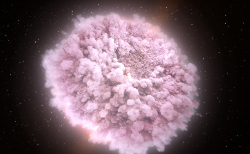 HEAPOW: Bursting Out All Over (2018 Apr 30)
HEAPOW: Bursting Out All Over (2018 Apr 30)
Accreting neutron stars are city-sized, incredibly dense balls of neutrons (or stranger stuff) paired with a normal star. The intense gravity of the neutron star pulls matter from its companion, so that the neutron star robs the companion star of a significant amount of its own stellar materal. This material falls, in a glowing stream, from the companion to the neutron star, forming a thin disk of inspiraling matter around neutron star. After spiraling through the accretion disk, and heating up to temperatures of millions of degrees, some of this matter will eventually settle onto the solid iron surface of the neutron star. As this accretion process goes on, more and more material builds up on the neutron star. This material consists of mostly hydrogen and helium, and becomes compressed by the intense surface gravity of the neutron star into a thin, dense hot layer spreading out over most of the surface. In extreme cases the density and temperature in this layer can become so high that the hydrogen gas explosively fuses together, like an explosion of hydrogen bomb, but one which explodes over the entire surface of the neutron star. The image above is a simulation of the hot, X-ray emitting material ejected from one of these global thermonuclear bursts. These explosions produce a rapid, near-blinding rise in the X-ray emission from the material surrounding the neutron star, which lasts for a few seconds and then fades thereafter. Detection of these types of events requires space telescopes with high sensitivity and quick response. The Neutron star Interior Composition ExploreR (NICER) is a new NASA X-ray telescope on the International Space Station designed to study X-ray variations from neutron stars and other sources. Its prime science is to study the interior state of neutron star's X-ray emission using X-ray emission from the star's exterior. NICER's combination of large collecting area and high timing capability make it a near-perfect instrument to unravel the mystery of how these global thermonuclear outbursts ignite and evolve.
Live Science: Mushroom Clouds Burst Through Neutron Stars
| << Previous HEAPOW | High Energy Astrophysics Picture of the Week | Next HEAPOW >> |